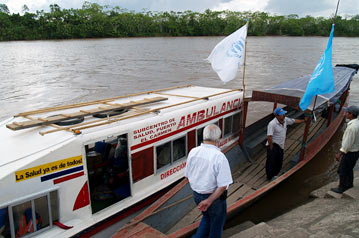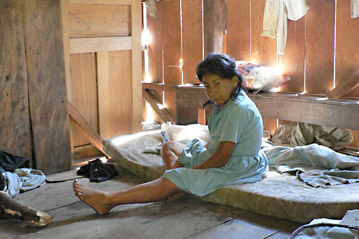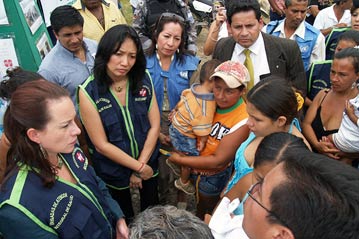Colombian refugees sail for 20 hours on high seas to reach Ecuador
Colombian refugees sail for 20 hours on high seas to reach Ecuador

TAMBILLO, Ecuador, February 7 (UNHCR) - Most Colombian refugees flee their country by land or air, but one group of 37 people was so desperate to escape from the violence that they braved the high seas in a small fishing boat to reach safety in Ecuador.
UNHCR is coordinating the distribution of emergency aid - including food, mattresses and hygiene kits - to the 19 adults and 18 children. The Colombians have been recovering since reaching the northern village of Tambillo on January 17 after 20 hours at sea.
The refugee agency has registered all the newcomers, who want to stay in Ecuador and seek asylum. UNHCR teams on both sides of the border are keeping an eye out for further movements of fleeing Colombians.
"We are determined to stay. I do not want my children to have to live through that kind of violence ever again," said 52-year-old Malena, who was accompanied by her four daughters and a grandson.
The refugees came from Bazan in south-west Colombia's volatile Pacific region of Nariño. They said they fled after a group of heavily armed men entered their village, gathered everyone on the football pitch and fired gunshots at their feet. "The next visit will be much worst," they quoted one of the gunmen as threatening.
The visit left the small community in shock - hundreds of people fled in the next few hours, most of them to other areas within Colombia. The 37 who arrived in Ecuador had previous contact with the people of Tambillo - both communities are Afro-Colombian and share a way of life based on small-scale fishing and agriculture. They are linked by trade and even family ties.
Located some 15 kilometres from the Colombian border, Tambillo is in a remote and underdeveloped part of Ecuador. The community has very basic infrastructure and there is much poverty, yet its 800 inhabitants reacted with spontaneous generosity when the group arrived.
"The local families opened their homes to the Colombians and shared their food with them," said Hanne-Meike Grol of the UNHCR office in Ibarra, almost four hours away by road and sea. "Tambillo is very isolated and it took a few days before we knew of the group's arrival and were able to help," she added.
Many in the group are worried about families left behind in Bazan, fearing that they might get caught up in combat. "It's nearly impossible to get out now, but as soon as they can leave I am sure many more of our people will come here for shelter," said Marta, 35, who came with her three children and is waiting for the rest of her family.
Border crossings from Colombia into northern Ecuador are frequent. Every month, UNHCR registers an average of 600 new cases. The real numbers are difficult to know since many hesitate to come forward as asylum seekers, either out of fear or lack of information. In all, an estimated 250,000 Colombians could be in need of international protection in Ecuador.
"This kind of influx is an example of the impact of the Colombian conflict on Ecuador," said Simone Schwartz, head of UNHCR's protection unit in Ecuador. She added that the refugee agency has developed good relations with the local people and authorities. "We call them our protection network. They play a key role in helping us provide a fast and effective response to refugees and asylum seekers in remote areas like Tambillo."
UNHCR Colombia has repeatedly expressed concern over the humanitarian situation in Nariño. Irregular armed groups are present in many rural areas and there is frequent combat. Thousands of people have been forced to flee in the past year, both within Colombia and to Ecuador. Ethnic minorities - both Afro-Colombian and indigenous - are suffering disproportionately from the violence.
By Xavier Orellana in Tambillo, Ecuador








